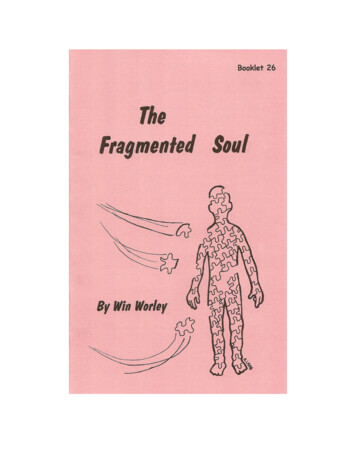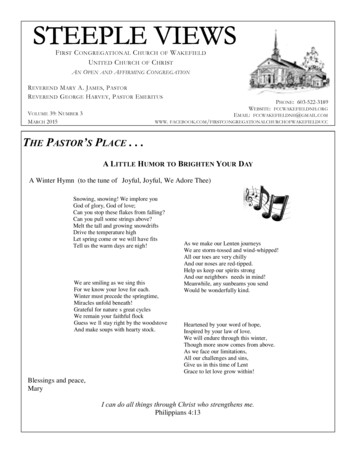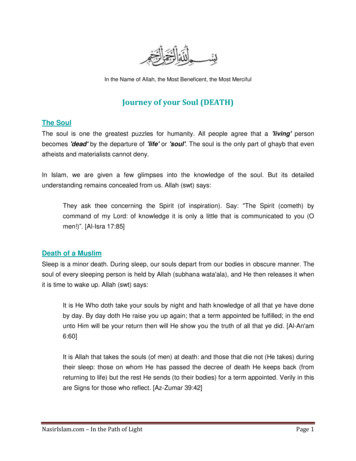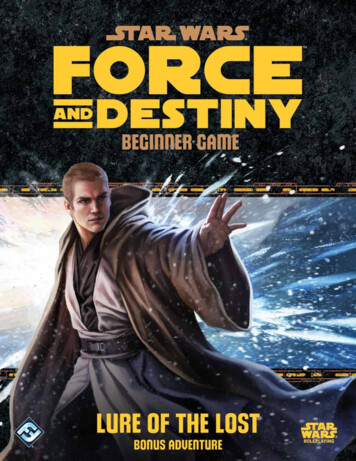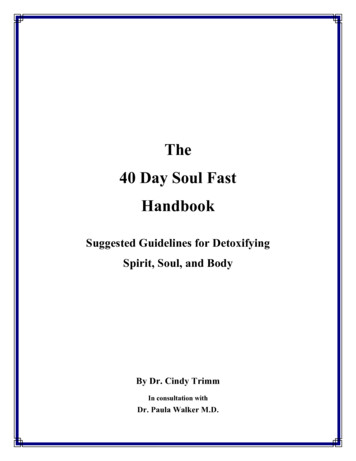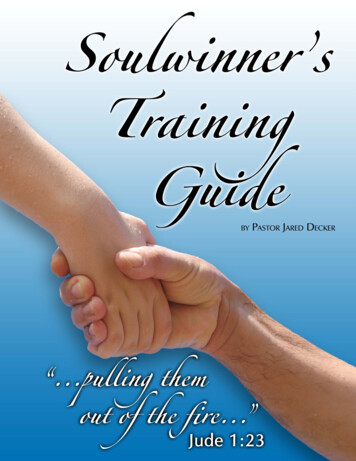
Transcription
BUNKAIThe lost soul of Karate-DoByGraham Palmer1
ContentsIntroductionChapter 1 – What is Kata?Chapter 2 – Bunkai: How was it lost? Where to find it?Chapter 3 – Tegu mi (grappling) explainedChapter 4 – Examples of bunkaiChapter 5 – Ground FightingConclusionBibliographyAppendix 1 – Right/Left HandednessAppendix 2 – Accompanying DVD2
“Karate has no philosophy. Some people think that the tradition of karate came fromBuddism and karate has a connection with the absolute, space and universe, but I don’tbelieve in that. My philosophy is to knock my opponent out, due to the use of only onetechnique. One finishing blow!” 1As far back as 1981, the beginning of my Martial Arts career, I could not have imaginedhow important the first ten years of my training would be to me. This nurturing decade ofmy training was to form a foundation of knowledge, from which I have learnt from,instructed from, and relied on (both inside and outside the dojo).My journey into the Martial Arts began by me joining a local judo club at the age of 10.In 1985 I enrolled into a Ju-Jitsu dojo, and one year later began my introduction intoShotokan karate. From 1986 I was training 6 to 7 days a week (judo twice, ju-jitsu twice,and karate two to three times a week).One may suggest that training in three different Martial Arts at the same time wouldhinder or confuse the student; I may even agree with that! However, I found theycomplimented each other very well. As my knowledge and skill grew in Shotokan ka rate,I found my attention started to wander from the other two arts. I left judo in 1987 and ju jitsu in 1992.As my study of Shotokan deepened, I still maintained an interest in the grappling arts, notas a separate system, but as a companion to my karate. It was my karate Instructor, SenseiMick Riddell, who encouraged me to incorporate what I had learnt into my Shotokan.Sensei Riddell later explained to me that he had always felt “there was more to karatethan just kick and punch”. He felt some of the moves in kata were not just a turn or a linkmove from one technique to another. It was not until he saw some of the grapplingtechniques I was using that he was able to see the possibilities of kata applications(bunkai).With encouragement from my Sensei I began to research and study the bunkai ofShotokan kata. This research has had an educational and rewarding affect on my karate.The students, who have accompanied me on this journey, have also gained a deeperknowledge and understanding of a complete Martial Art.The following work is a result of 15 years study of bunkai. Many of the findings havebeen largely due to my early training in the grappling arts. Without this knowledge Ibelieve I would not have been able to make the discoveries I have.I consider myself extremely fortunate to have gained this knowledge from an early age. Iwould like to present my findings in the following work.1Sensei Yahara SKM issue 79 page 6.3
In chapter 1 I look at what the word “kata” means and how they should be practised. Howkata has become a “physical exercise”, far removed from its original purpose of killing orseriously injuring an opponent.In chapter 2 I explore the reason why kata has changed, and why it has lost the mostimportant aspect of its original design (bunkai). How , due to the “modernization” andgrowth of karate, bunkai has become a “casualty” of its development. I also share myconcern that, if we as the next generation do not address this area now, bunkai may belost forever.I outline the methods used to explore bunkai; this will cover the basic elements needed tounlock the secrets of kata. I also include the grappling training drill I use with my ownstudents, which has proven to be a productive element to their study of karate.In chapter 3 I explain the little known skill of “Tegumi”, better known as grappling. Thisarea of training is one many karate-ka fail to study, mainly because it has been neglectedfor so many years. My intension is to revive this forgotten art, and put it back intomainstream karate practice.In chapter 4 I show practical examples of bunkai which I have discovered from myresearch. The applications will centre on the grappling aspect which exists in Shotokankata. I hope to present an objective view which asks why grappling has been neglectedand almost lost from the practice of Shotokan karate.I have left out any striking applications, because these are already well documented in themany karate books available. May I stress here that the examples I demonstrate are onlyone possible explanation of bunkai, and remind the reader that “no one way is the correctway”.Chapter 5 will cover Ne-waza, an almost “taboo” subject with regards to karate. Myresearch has shown that many karate-ka do not consider fighting on the ground an option.Although this may be true in an ideal world, personal experience and studies from otherlikeminded Instructors have shown that a violent confrontation may end up on the floor.If this was to be the case, the karate-ka who neglects ground fighting will find himself(may I use the term) “like a fish out of water”!Looking back on my development now, I am very grateful to my Sensei for hisencouragement and guidance. It is because of my Sensei’s foresight that I was able todiscover and unlock some of the wonderful secrets hidden within our kata.I would like to thank both my parents, and my Sensei for their support and faith. I wouldalso like to thank my wife Lorna for her relentless encouragement and patience. Withoutthese people the following pages would not have been possible. For this I am forever indebt to them.May 20044
Chapter 1What is Kata?5
The Japanese word “Kata” means form, although it is usually translated as “formalexercise”. Kata are sets of movements or techniques, performed in the same way everytime, starting and finishing at the same spot. This is known as Embusen (the line ordirection of kata). Kata are performed with varying speed, strength, and athleticism. Kataperformed correctly are both physically and mentally demanding.There are more than 50 kata which exist today, within the many styles of karate. Someare variations of the same kata. Certain kata within the Shotokan system (of which thereare 26) originate from Chinese Hsing (“Hsing” is Chinese for kata).However, with the development of karate, first by the Okinawans and then by theJapanese, today’s kata has its own Japanese identity and feeling, far removed from itsoriginal Chinese parents.Kata has many different meanings to every Martial Artist. Almost all modern karatestyles or schools use kata as part of their grading syllabus. Students are required to learn adifferent kata for each grading examination. Some students find it a challenge as to howmany kata they can learn. Some use the kata for competition, winning trophies andsometimes even money. There are also some who say “kata is a waste of time”!!I feel the term “formal exercise” does not give a true explanation of what kata reallymeans, or what it has to offer. To refer to kata as merely an “exercise” would imply theonly use would be to improve a person’s physical ability. It is true that training in katadoes improve one’s fitness; however, it is not the main purpose of kata.Kata must be practised with bunkai (applications); this is where the techniques performedin the kata are used against an opponent. Practicing the kata in this way will enable thekarate-ka to use the kata for self defence. However, I have found when teaching bunkai tokarate-ka many do not practise this and only concentrate on the performance or physicalside of kata.To use a metaphor, if kata were a gun the performance of kata would be the same aspolishing and cleaning the gun. The bunkai would be the firing of the gun. We can clearlysee that the “firing” of the gun is what it was “designed” for. The “cleaning” is tomaintain its “working” condition; this is not dissimilar to the purpose behind kata.Each kata is said to cover a complete combat system, which varies in content andappearance, according to the creator’s unique body set up. 2 The movements of the kataare performed in such a way to enable the karate-ka to remember and practice thetechniques used to defend against the habitual acts of violence.We can not accurately say when kata were created. There is little written evidence toshow when kata were first used. What we do know is the early pioneering karate2Burgar “Five Years One Kata” pages 29/30.6
Instructors of the 1800s practised kata. They also regarded kata as the most importantarea of their karate study (kumite as we know it today, was not practised until the 1930s) 3 .Prior to the 1920s, the main emphasis of training was kata. A student would study asingle kata for up to three years, before moving on to another. The student would not onlylearn the performance of the kata. He would also practise the “applications” of the katawith a training partner (this would be regarded as kumite).Master Gichin Funakoshi (1868-1957) recalls this concept of training on Okinawa. “Inthe past, it was expected that about three years were required to learn a single kata, and itwas usually that even an expert of considerable skill would only know three or at mostfive kata”. 4It is interesting to note that in today’s dojos, within 3 years of training a student would beeither a brown belt or even a black belt. A student of this grade would have 7 to 9 kataunder his belt. A further 3 to 5 years of training, and the student would know the entireShotokan kata syllabus, all 26!We can also see the importance of kata in other Martial Arts such as “Koryu Bujustu”(old tradition Martial Arts). Mr Hunter Armstrong explains the importance and purposeof kata within the old Japanese Martial Arts of the Bushi (Japanese warrior). “The katawere profound systems of integrated movements and behaviours. The purpose of katadesigned for combative application was not to develop the individual’s ability to respondto any attack with a choice of a wide variety of techniques, but to train that individual toeffectively utilize a select few proven techniques in response to a wide variety of attacksor combative situations”. 5It is interesting to note the wording of “a select few proven techniques”, as this is exactlywhat our karate kata are teaching us. We are not learning how to defend against “any”attack, with a “wide variety” of techniques (how could we?) The kata are teaching us touse the “proven techniques” chosen by the creator, against the most likely of attacks, the“habitual acts of violence”.From this information we can safely say that kata were created with knowledge gainedfrom “combat experience” for the sole purpose of either killing or seriously injuring anopponent. The kata were studied to prepare the warrior for the battlefield and thecivilian for the attacker in the street.3Burgar “Five Years One Kata” page 30Funakoshi “Karate-do Kyohan” page 385Hunter “Koryu Bujutsu” page 2347
Chapter 2Finding Bunkai“The lost soul of karate-do”8
We know that kata was very important to the karate-ka of pre-1920. We also know thatan important part of the kata was the study and use of bunkai. 6 These two elementsworked hand in hand, one did not exist without the other. So why has bunkai become alost and neglected force from Shotokan karate?Around the beginning of the 20th century, karate began to change and become“modernized” . This was a result of the Meiji (1868-1912) restoration, when Japan was ina state of reform and modernization. This reform also affected the Island of Okinawa.Master Itosu (1832-1915), a very famous karate-ka of Okinawa, began to create a modernstyle of karate. 7 Karate was accepted into the school curriculum at this time, and it wasMaster Itosu who was chosen to teach at these schools. Some of the movements of katawere changed, or new ones created so that school children could learn a “safe” andphysical Art.8 Itosu is credited with creating the Pinan kata (later to be renamed as Heian) ,which were taught to school children as an introduction into karate. 9Master Chojun Miyagi (1888-1953) founder of Goju-Ryu karate-do wrote in his Outlineof karate -do 1934, “In April 1901 karate became part of the physical educationalcurriculum. This was the first stone in the foundation of group teaching.” This commentfrom Master Miyagi shows a sense of uncertainty about the direction karate was taking,which was shared by other Okinawan karate Masters of this time. Large group trainingwas not common practice on Okinawa.Karate made its way to mainland Japan where it was introduced into the educationalsystems and accepted as a Japanese Martial Art. This was largely due to the efforts ofMaster Funakoshi, who is regarded as “The Father of modern day kar ate”.Master Funakoshi s intention was to promote and spread the Art of karate across Japan;this he achieved and much, much more ! However, in doing so the concept of bunkai wasleft behind. Not intentionally, but by the time karate had been accepted and gainedmomentum, it was too late for Funakoshi to introduce the deeper meanings of kata i.e.bunkai. 10Master Funakoshi passed away in 1957, and by this time karate had evolved and beenscientifically refined. The practice of karate had changed to the drilling of large groups,mainly in kihon and kata for form. The emphasis on kumite increased and competitionfighting was commonplace. Also with a structured grading system, karate was ready to bespread across the world.Shotokan karate reached Britain around 1956/57, due to the effort of Mr Vernon Bell(1922-2004). Mr Bell was the founder of the British Karate Federation (BKF), the first6Egami “The Heart of Karate-do” page 41H Cook “Shotokan karate a precise history” page 248Page 288 ibid.9Page 24 ibid.10Page 162 ibid.79
karate organization in Britain. 11 From this time kara te flourished and spread across thewhole country, dojos opened in almost every town and the karate “craze” was adopted.Over 40 years later karate has become an extremely popular pastime for many people; forothers it has become “a way of life”.Training followed that of Japan, centered on kihon performed in lines, up and down thedojo. Kata was taught mainly for grading purposes, emphasis was placed on correctperformance and form. Kumite was “fast & hard” and conducted from a mid to longrange distance.Such training areas as Bunkai, Makiwara, pad work and Hojo undo (Okinawan weighttraining) have all been lost to the past. Of cour se I am generalizing here, and I know of afew dojo which still maintain these training skills. However, this is not common practicefor many Shotokan karate dojo across Britain, or the World!I believe it was this change to “modernizing” karate which led to the loss of bunkaiwithin Shotokan karate. Although, with everything which evolves, there has to becasualties. Bunkai is one such casualty of karate reaching a world-wide practice.We as the next generation are responsible for recapturing this “lost soul” and putting itback into mainstream practice. Not just for posterity, but for a practical reason.We must also be grateful to Master Funakos hi, because if it were not for his foresight ofintroducing karate to Japan when he did, I do not believe we in Britain would havereceived it a soon as we did. Just imagine if karate had not been introduced to Japan until,say, the 1940s; Britain might not have seen anything until the 1980s!Where do we find bunkai?The “karate book” was first published in the 1920s with notable classics from greatMasters such as Funakoshi, Motobu, Miyagi, Mabuni, etc. The karate book made itpossible for the karate-ka to enhance his practice and study away from the dojo.Prior to this time the student had to rely on first-hand Instruction from his Sensei. If hewas to practise at home, his memory was the only training aid available. The karate bookplayed a very important role in the development of karate.Many of the karate books available do have sections on bunkai. How ever, most of themonly show a “selection” of bunkai and never seem to dedicate any depth to the subject. Ifind this quite strange, as we are repeatedly told that kata are so very important tokarate,12 but there does not seem to be any importance placed on bunkai.11A detailed account of Mr Bell and British karate can be found in “Shotokan Dawn Vol.1&2” by CLayton.12Funakoshi “Karate-do Kyohan” page 38.10
I have read several books with “kata application” in the title, only to find inside the katamovement demonstrated all the way through, and you guessed it, a “selection” of bunkai.Now some of these examples of bunkai do give the reader an idea as to what themovements may represent. Unfortunately, many of the examples of bunkai I findsomewhat dubious or difficult to perform. Examples of these will be explained later.As technology developed, the video recorder was widely available to everyone. With thiscame the introduction of the “karate video”. This marve llous new training aid helpedconsiderably in the education and development of the karate student.The general trend of contents for the karate video is again the perfection of movement inkihon, kumite and of course kata. There are once again examples of kata bunkai toaccompany the kata, but I am afraid no great depth is shown. Although, in recent yearsthere are a few videos available solely dedicated to kata bunkai, this is not the norm. 13The “karate course” is another additional training device. This is where the karate studenttravels to different parts of the country to train with various instructors, obtainingknowledge and skill from the best instructors in the country.Once again there is only a handful of karate instructors who choose to teach kata bunkai.I have found if one trains with instructors such as Sensei Hazard, Cook, Trimble, Oliverand Carroll, one will gain a very good insight into kata bunkai. However, many karatestudents do not, or cannot travel to these courses.So if the books only have a very limited “selection” to offer, the videos are becomingmore available (but not extensive), and the courses are not always practical for everyoneto attend. Where do we find the bunkai to our kata?We find it ourselves! Before I outline the methods I use to discover bunkai, I feel anexplanation of what the word “Bunkai” actually means is necessary.The word bunkai is a term widely used to describe the applications of kata. However,bunkai on its own does not cover all aspect of kata application. We can split the conceptof kata application into three areas:1. Bunkai – “analysis” of technique.Bunkai is the first stage of the process. At this stage we analyse the techniques of the kata.We figure out what the techniques may mean and what they could be us ed for and howthey may be applied in a self -defence situation. We give ourselves an idea of what thekata is telling us. We try and understand in what way the creator used the kata.13Simon O liver has a complete series dedicated to bunkai.11
2. Oyo – “application” of technique.Oyo is the result of bunkai. Here we take what we have learnt from the analysis of thekata, and apply it with a partner. We try out the ideas we have come up with, and throughtrial and error we discover a practical solution to the t echnique. There may be several oyoto one technique. This is where we move onto Henka.3. Henka – “variation” of application.Henka is a development of oyo. Once we have discovered what the technique means andhow to apply it, we can develop variations to that technique. The henka may not lookidentical to that found in the kata. However, the variation must have the same principlefound in the kata and displayed in the bunkai and oyo.For example, the choke found in Tekki Shodan14 can be applied as a leg take-down.15Same arm, same leg forward, forearm pushes and the other hand pulls, are exactly thesame in both applications, the only difference being, one is applied to the throat, the otherapplied to the leg. Many of the applications found in kata can be used both standing or onthe ground, examples of which will be shown later.Methods used to discover bunkai:1. Research: Use as many research areas as possible, for example: Read a good varietyof books on the Martial Arts; do not limit oneself to books only on Shotokan karate.Much of my bunkai research has come from learning about different karate styles andChinese systems.Try to find an older version of a kata; this will show how the kata was performed prior toany changes. This should provide a clearer explanation of the technique used. This isevident in the kata Unsu, where the two mawashi-geri performed from the ground wereoriginally ushiro-geri. 16 Or in Nijushiho where the two yoko-geri kekomi were originallyknee lifts. 17 Videos and the internet are both very good areas to explore; however as Ihave already explained there are not many videos specifically dedicated to bunkai.2. Analyse each movement: Look at each technique and find several reasons for its use.Make sure that you give each technique more than one reason or application. The greatervariety of reasons you give each technique, the wider and deeper the application will be.3. Keep it simple: Try to keep the applications as simple as possible. Remember thesetechniques must be used while under pressure. Adrenalin or fear WILL be an important14See example 5 page 27See example 9 page 3016Kenei Mabuni “Shito-Ryu Karate-do” page 10217S Langley “Shotokan karate magazine” No.72 page14.1512
part of defending yourself in a real confrontation. Avoid complicated combinations orstrikes which require extreme accuracy.4. Think laterally: Things are not always what they may seem. Just because we arelooking forward in the kata, does not mean the technique is applied in that direction.Many times the application is applied to the rear, although the technique is performedforward. For example we can see this applied in the kata Unsu.18Blocks can also be used as strikes, disengages, locks, strangles or holds, examples ofwhich will be explained in chapter 4.Jumps found in kata usually represent a throw being used. The effort used to lift oneselffrom the ground can be seen as the same physical effort used to throw a person. This isdemonstrated clearly in the ka ta Heian Godan, Empi, Unsu and Kanku-Sho. 19Changing direction in kata is usually seen as facing another opponent. This of course canbe true. However, if we look at some of the turns with the accompanying foot and handactions, we can clearly see examples of throws being used. A prime example is the turnfrom yama-zuki into zenkutsu-dachi / sukui-uke, found in Bassai-Dai. 205. Habitual Acts of Violence is a term used to describe a collection of actions andbehaviour which one can expect to find when dealing with a violent confrontation. Thelist below shows a good selection of common actions one would expect to encounter:Round punchStraight punchUpper-cutLapel grab – single/doublePushes – single/double handThroat grabGrabs from behindFinger pointingFootball style kickHead buttHead chancery – front/reverseBear hug – front/behind (over & under arms)Rugby tackle21Of course this list can be added to; these are just examples. When analysing the techniqueof the kata, one must use the habitual acts of violence to help find their possible meaning.It is a good idea NOT to use karate style techniques to defend against, because these are18See example 10 page 31.See example 7 page 28.20See exa mple 8 page 29.21B Burgar “Five years one kata” page 55.1913
not used by the average attacker in the street. The HAOV also tells us that the majority ofpeople are right-handed22 and of an average height.23 With this in mind the applicationmust address these facts, and one must practise the appropriate defences.6. Partner work: This is a very important part of the whole bunkai analysis. The resultsof the analysis are practised with a training partner, and through “trial and error” aworking application of the kata is found. Do not be afraid to throw away applicationswhich do not sat isfy one’s own beliefs - kata bunkai is a personal study. Someapplications will be univer sal and work for most karate-ka. There will be otherapplications which will only suit a particular individual; this is because of our uniquebody set up, which means we are all different.7. Tegumi (grappling) : Knowledge of grappling is essential as a “back-up” system,when it is not possible to strike. The pre-emptive strikes of karate must be our first line ofdefence however, this is not always possible. Once the “fighting distance” is closed and agrapple has begun, knowledge in this field will pay dividends in the street. A basicunderstanding of grappling methods will help unlock kata bunkai.The following is a training drill I use with my students. This is a perfect way of educatingthem with a good understanding of essential grappling skill, which combined with theirstriking skills, sets them up to address the complex study of kata bunkai.I have found within only a few months of practice, students of all grades becomecompetent with the grappling techniques used here. Once the drill is lea rnt correctly, itcan be practised as a whole or broken down into sections. I have found once learnt thedrill only requires 5 to 10 minutes of regular practice to keep it “fresh” in the studentsmind.Arm BarFigure-4Arm Bar (inside)Back hammerTegumi training drill Vol. 1Group 1: Arm locks2223See Appendix 1.B Burgar “Five years one kata” page 4914
Group 2: Strangles/Chokes1. Bar Choke2. Guillotine3. Rear Choke4. Rear StrangleGroup 3: Wrist locks1. ‘S’ Lock (radius/ulna twist)2. Two hand wrist lock3. Chicken Wing4. Wrist/shoulder lock15
Group 4: Forward throws1. Hip Throw2. Shoulder Throw3. Sweeping hip throw4. Body drop throwGroup 5: Backward Throws1. Outside reaping throw2. Inside reaping throw3. Leg throw4. Double leg throw16
Group 6: Securing & locking on the ground1. Straight arm Lock2. Wrap-up Lock3. Cricket Bat4. Wrist Lock into Turn Over17
Chapter 3Tegu mi explained18
I have learnt from my experience of teaching grappling techniques to karate-ka that manyhave little if any knowledge of grappling. This shows clearly that grappling is an areamany karate dojos fail to practice.The longer I explore kata the more I am convinced that grappling plays an important partto the application (bunkai) of it. We know that grappling was used in the early 1900s andmany of the kata were changed, with the grappling techniques removed to make karateready for the introduction to the school curriculum. 24 As a result karate has developedand left the grappling aspect behind; if we do not pay attention to it now it may be lostforever.I feel it is important at this stage to explain the principles of the grappling techniquesused in the following examples. This will give those karate-ka with no knowledge ofgrappling a brief introduction into this complex art. I will explain the principles of locks,strangles/chokes and throws. Please remember whenever training with locks, strangles orchokes you MUST adhere to the “tap” safety system.This is most commonly used in Judo dojos, where a student would “tap” his partner(usually twice) to indicate submission. This tapping tells the person applying thetechnique that it is working. As soon as you feel, see or hear your partner tapping youmust STOP any further pressure.Locks: How do they work?This generally refers to joint manipulation. Where you find a joint you should be able to“lock it!” Commonly locks are applied to the elbows, shoulders, wrists and fingers.Legs, knees and toes are also possibilities. However, upper body limbs are more available,certainly from a grappling situation in the street.An elbow, for example, can be ‘locked’ by extending the arm to the point where it willnot straighten any more. By providing a fulcrum just above the elbow, and applyingpressure so the arm hyperextend past its natural point, will cause extreme pain and ifenough pressure is used, the elbow/arm will break. The fulcrum can be a forearm, knee,stomach or even the back of the neck. It really depends on the situation with the attackerand oneself.This principle of providing a fulcrum at the joint and applying pressure is the same foralmost all joints, and is not uncommon to everyone! Just think of how you would break apencil or stick.For a pencil you would hold it at either “end” and place your thumb/thumbs in the“middle”. By applying pressure forward with your thumbs and backwards with your24A Trimble “Karate kata and applications 4” page 20.19
hands, the pencil will bend and if continued pressure is applied, the pencil will break. If alarger stick were to be broken, you may need to use your knee as a fulcrum.Consider where you would place your thumbs or knee in both examples; they would be inthe middle. If placed closer to the ends, the break becomes more difficult. One wouldassume this to be an obvious statement. However, when asked to apply this theory tosomeone's joint or limb, there seams to be a loss of logical thinking by many karate-ka.You will also come across the odd “rubber man” - the person who has naturally supplejoints. Locks will not always be effective on these people. Also if a person is ratherstrong in his upper body, you may find arm locks not effective either. Fingers are a farbetter option!So what happens if a lock does not work? Well it is the same as if a punch did not work,if you missed the target or it just was not effective. You follow up with another orsomething different, you use a combination. An example of this can be seen in the kataSepai. Where a straight arm lock is applied and failed, the body is turned, the testicles arestruck and a figure four arm lock is applied to the rear.I must state here that when practicing the locks, at first concentrate on applying the lockand making it work. You must remember that striking is going to be applied along withthe application of the
Chapter 5 will cover Ne-waza, an almost "taboo" subject with regards to karate. My research has shown that many karate-ka do not consider fighting on the ground an option. Although this may be true in an ideal world, personal experience and studies from other likeminded Instructors have shown that a violent confrontation may end up on the .


